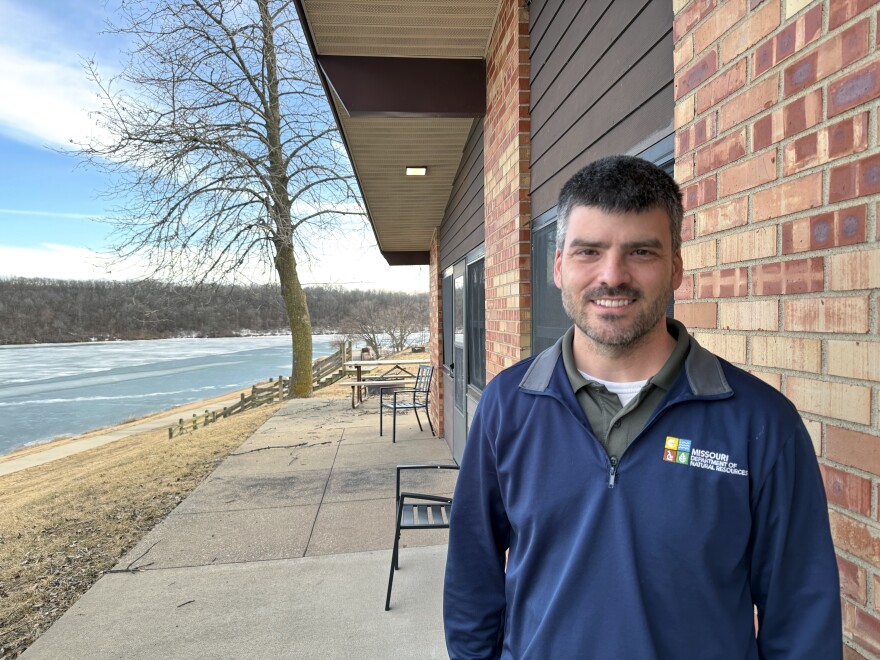Humans have inadvertently filled their towns and cities with outdoor lighting that generates a lot more light pollution than is necessary.
This costs communities their starry nighttime views. It also wastes electricity and hurts pollinators and other creatures.
But experts on reducing light pollution say good design is the solution. Outdoor lighting can work well for humans without spoiling night skies nearly so much as has become common today.
Take the cabins at Thousand Hills State Park near Kirksville, Missouri. Until recently, globe-shaped fixtures with bright white bulbs lit up each door.
That shape and color can backfire on people’s night vision, making it harder for their eyes to adjust and making shadows outside the cabins appear darker.
Park staff removed the globes and installed new fixtures that lie flush with the cabin awnings and contain amber bulbs.
That’s because effective outdoor fixtures light up the surfaces people need to see — in this case, the door and the ground just outside the cabin — without shining light directly into people’s eyes the way a globe does. Also, amber is a less jarring color for our eyes at night and it is less disruptive to wildlife.
Thousand Hills State Park is the twelfth Urban Night Sky Place in the world, certified by DarkSky International for its efforts.
Homeowners who would like to waste less energy and help the wildlife that lives in their neighborhoods can take a page out of the DarkSky movement’s book to reduce their own contributions to light pollution.
This graphic created by the Mont-Mégantic International Dark Sky Reserve shows a typical, problematic outdoor light on the left and then progressively makes it better with the series of changes shown to the right. Those changes include:
- Installing a shield that directs the light downward
- Switching to an amber or orange bulb
- Using a bulb that is no brighter than necessary for the specific outdoor space
- Turning off the light when it’s not needed (or installing a timer or motion sensor to make sure this happens automatically when people aren’t around)
Here are those steps in more detail:
Use fixtures that restrict light to a downward angle
Picture a typical lamp post with a glass globe on top. It has two key flaws that waste energy and cause unnecessary skyglow and glare.
First, it allows light to shine upward, brightening the sky. Second, it releases much of its light horizontally, too, hitting the eyes of passersby.
The average neighborhood in Kansas and Missouri is full of street lights, garage lights, and other lights that make similar mistakes — sending light into the sky or into people’s eyes.
Dark-sky friendly fixtures make sure that light travels downward, says Vayujeet Gokhale, a physics and astronomy professor at Truman State University and a board member of DarkSky Missouri. This makes sure the fixture lights up the area you’re trying to see, while reducing glare and skyglow.
The Greater Big Bend International Dark Sky Reserve website features simple graphics and guidance to demonstrate how to improve outdoor lighting with fixtures that point light downward, among other changes.
If changing fixtures doesn’t fit into the household budget, Gokhale recommends choosing shielded fixtures the next time home repairs or renovations make the purchase of a new fixture necessary.
Opt for amber or orange bulbs
Next time you find yourself perusing bulbs at the hardware store, also look for a kelvin number on packages.
This relates to the color of the lighting, and a lower number means the bulb will be more yellow, amber or orange.
Gokhale recommends choosing something in the range of 2200 to 2700 kelvin.
“Certainly below 3000 Kelvin,” he said. “Or just look at the color. And the more amber color it is, the better off you are, generally speaking.”
White lights mimic daylight, causing more disruption to wildlife.
Try using softer lights with lower lumens
Since a good fixture doesn’t waste light upwards and horizontally, it won’t take as much energy to light up the ground.
Using more lumens than necessary wastes electricity and can also backfire on human vision at times.
Gokhale says it’s worth trying bulbs that produce fewer lumens. (The lumen number on the package tells you how bright a bulb is.)
It’s difficult to set a fast rule on how many lumens people should opt for. It depends on factors such as the size of the space that requires lighting and how many bulbs are present.
Is that light even useful? Is it useful right now?
One of the most important principles for reducing light pollution is turning off lights when they’re not in use and removing lights that don’t serve a purpose.
Motion sensors or timers can help ensure that porch and garage lights turn off when no one is outside, for example.
“Now, there are legitimate security concerns,” Gokhale said. For example, businesses may need to keep lighting on property that is vulnerable to theft. But he says well-designed lights can fill this role without producing excessive light pollution. “Good lighting is fine.”
When used properly, LED lights can point light where it is needed without spilling it onto the property of neighbors or into nearby woods and other habitats.
“LED lights are very directional,” he said. “You can design the light fixture so that if you say the light needs to cut off at the edge of my lot, you can design lights like that.”
Celia Llopis-Jepsen is the environment reporter for the Kansas News Service and host of the environmental podcast Up From Dust. You can follow her on Bluesky or email her at celia (at) kcur (dot) org.
The Kansas News Service is a collaboration of KCUR, Kansas Public Radio, KMUW and High Plains Public Radio focused on health, the social determinants of health and their connection to public policy.
Kansas News Service stories and photos may be republished by news media at no cost with proper attribution and a link to ksnewsservice.org.











